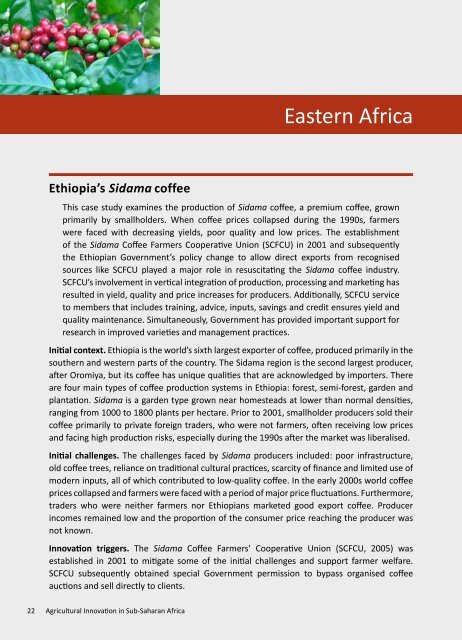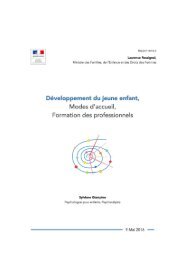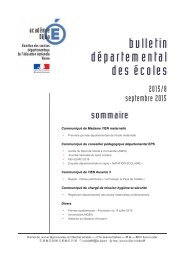agrl_innovations_in_ssa.pdf?utm_content=buffercb41d&utm_medium=social&utm_source=twitter
agrl_innovations_in_ssa.pdf?utm_content=buffercb41d&utm_medium=social&utm_source=twitter
agrl_innovations_in_ssa.pdf?utm_content=buffercb41d&utm_medium=social&utm_source=twitter
You also want an ePaper? Increase the reach of your titles
YUMPU automatically turns print PDFs into web optimized ePapers that Google loves.
Eastern Africa<br />
Ethiopia’s Sidama coffee<br />
This case study exam<strong>in</strong>es the production of Sidama coffee, a premium coffee, grown<br />
primarily by smallholders. When coffee prices collapsed dur<strong>in</strong>g the 1990s, farmers<br />
were faced with decreas<strong>in</strong>g yields, poor quality and low prices. The establishment<br />
of the Sidama Coffee Farmers Cooperative Union (SCFCU) <strong>in</strong> 2001 and subsequently<br />
the Ethiopian Government’s policy change to allow direct exports from recognised<br />
sources like SCFCU played a major role <strong>in</strong> resuscitat<strong>in</strong>g the Sidama coffee <strong>in</strong>dustry.<br />
SCFCU’s <strong>in</strong>volvement <strong>in</strong> vertical <strong>in</strong>tegration of production, process<strong>in</strong>g and market<strong>in</strong>g has<br />
resulted <strong>in</strong> yield, quality and price <strong>in</strong>creases for producers. Additionally, SCFCU service<br />
to members that <strong>in</strong>cludes tra<strong>in</strong><strong>in</strong>g, advice, <strong>in</strong>puts, sav<strong>in</strong>gs and credit ensures yield and<br />
quality ma<strong>in</strong>tenance. Simultaneously, Government has provided important support for<br />
research <strong>in</strong> improved varieties and management practices.<br />
Initial context. Ethiopia is the world’s sixth largest exporter of coffee, produced primarily <strong>in</strong> the<br />
southern and western parts of the country. The Sidama region is the second largest producer,<br />
after Oromiya, but its coffee has unique qualities that are acknowledged by importers. There<br />
are four ma<strong>in</strong> types of coffee production systems <strong>in</strong> Ethiopia: forest, semi-forest, garden and<br />
plantation. Sidama is a garden type grown near homesteads at lower than normal densities,<br />
rang<strong>in</strong>g from 1000 to 1800 plants per hectare. Prior to 2001, smallholder producers sold their<br />
coffee primarily to private foreign traders, who were not farmers, often receiv<strong>in</strong>g low prices<br />
and fac<strong>in</strong>g high production risks, especially dur<strong>in</strong>g the 1990s after the market was liberalised.<br />
Initial challenges. The challenges faced by Sidama producers <strong>in</strong>cluded: poor <strong>in</strong>frastructure,<br />
old coffee trees, reliance on traditional cultural practices, scarcity of f<strong>in</strong>ance and limited use of<br />
modern <strong>in</strong>puts, all of which contributed to low-quality coffee. In the early 2000s world coffee<br />
prices collapsed and farmers were faced with a period of major price fluctuations. Furthermore,<br />
traders who were neither farmers nor Ethiopians marketed good export coffee. Producer<br />
<strong>in</strong>comes rema<strong>in</strong>ed low and the proportion of the consumer price reach<strong>in</strong>g the producer was<br />
not known.<br />
Innovation triggers. The Sidama Coffee Farmers’ Cooperative Union (SCFCU, 2005) was<br />
established <strong>in</strong> 2001 to mitigate some of the <strong>in</strong>itial challenges and support farmer welfare.<br />
SCFCU subsequently obta<strong>in</strong>ed special Government permission to bypass organised coffee<br />
auctions and sell directly to clients.<br />
22 Agricultural Innovation <strong>in</strong> Sub-Saharan Africa






